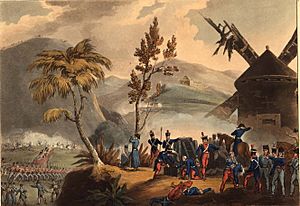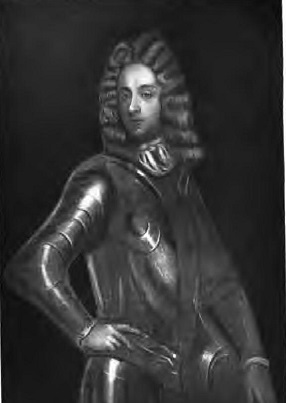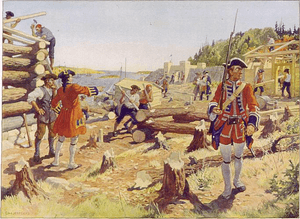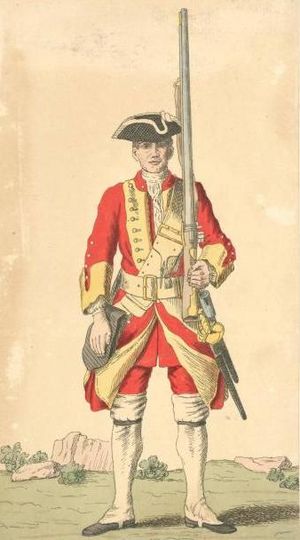29th (Worcestershire) Regiment of Foot facts for kids
Quick facts for kids 29th (Worcestershire) Regiment of Foot |
|
|---|---|

Badge of the 29th (Worcestershire) Regiment of Foot
|
|
| Active | 1694–1698 1702–1881 |
| Country | |
| Allegiance | |
| Branch | |
| Type | Regiment |
| Role | Infantry |
| Garrison/HQ | Norton Barracks, Worcestershire |
| Nickname(s) | "Two and a Hook", "The Ever Sworded 29th", "Vein Openers" and "Guards of the Line" |
| Colors | Yellow Facings |
| March | Royal Windsor, 1791 |
| Anniversaries | The Glorious First of June 1794 |
| Engagements | War of the Spanish Succession
Boston Massacre
|
| Commanders | |
| Notable commanders |
|
The 29th (Worcestershire) Regiment of Foot was a famous infantry (foot soldier) regiment of the British Army. It was first formed in 1694. Later, in 1881, it joined with another regiment to become the 1st Battalion, the Worcestershire Regiment. This change happened because of new army rules called the Childers Reforms.
Contents
History of the Regiment
Early Years: 1694 to the 1700s
This regiment was created on February 16, 1694. It was during a big war called the Nine Years War. Colonel Thomas Farrington started it, and it was first known as Thomas Farrington's Regiment of Foot.
The regiment was stopped in 1698 after a peace treaty. But it was started again in 1702 when the War of the Spanish Succession began. It was supposed to go to the West Indies, which was a tough place for soldiers. However, Colonel Farrington managed to get them sent to Flanders instead. They joined Marlborough's army there in 1704.
They missed the famous Blenheim but fought in the Battle of Ramillies in May 1706. They also helped in the siege of Ostend in June. After Colonel Farrington died in 1712, Lord Mark Kerr became their new leader. As the war ended, the regiment moved to Gibraltar. They stayed there for 30 years, even during the Siege of Gibraltar from 1727 to 1729.
North America and New Nicknames
During the War of the Austrian Succession (1740-1748), the regiment was in British North America. They helped capture the French stronghold of Louisbourg in October 1745. In 1746, 27 soldiers died in the Port-la-Joye Massacre. This happened partly because they were not carrying weapons.
After this, officers were told to always carry their swords and side arms. This led to their famous nickname, the Ever Sworded. The regiment stayed in North America after the war. In 1749, they helped build the town of Halifax, Nova Scotia. This was during a conflict known as Father Le Loutre's War.
In 1751, a big change happened for all regiments. Before, regiments were named after their leader and often disbanded. Now, each regiment got a number based on how old it was. So, Colonel Peregrine Hopson's Regiment became the 29th Regiment of Foot.
George Boscawen became the new Colonel in 1752. His brother, Admiral Edward Boscawen, gave him 10 young black drummers. They had been taken during the 1759 Invasion of Guadeloupe. This tradition of having black drummers continued until 1843.
The Boston Massacre and American Revolution
In 1768, the 29th Regiment was sent to Boston. On March 5, 1770, some soldiers from the regiment were involved in the Boston Massacre. This happened when five colonists died during a riot near the Boston customs house. The 29th was later called the Vein Openers. This nickname meant they were the first to shed blood in the events leading to the American Revolution.
The soldiers involved were put on trial for murder. John Adams, who later became a President of the United States, defended them. Two soldiers were found guilty of manslaughter and branded on their thumbs. The others, including Captain Thomas Preston, were found not guilty. After the trial, the regiment moved to Florida in 1771 and then to England in 1773.

During the American Revolutionary War in 1775, the 29th Regiment helped defend Quebec City. In 1777, some of their companies joined the Saratoga campaign. They fought at the Battle of Hubbardton on July 7. However, these companies had to surrender after the Battles of Saratoga in October 1777. The rest of the regiment stayed in Canada. They fought in smaller battles along the borders of Vermont and New York.
On August 31, 1782, the unit got a new name: the 29th (Worcestershire) Regiment of Foot. This was part of a plan to help regiments get more recruits from specific counties.
The regiment returned to England in 1783. In 1791, they received their regimental march, 'The Royal Windsor'. It was supposedly written by Princess Augusta.
When the French Revolutionary Wars started in 1792, the 29th Regiment played a special role. In 1794, some of their soldiers served as marines on British warships. They were part of a big naval victory known as the Glorious First of June. The regiment was given a special naval crown badge for their bravery in this battle. One of their ships, HMS Brunswick, even sank a French ship.
Later in 1794, a group of 29th Regiment soldiers went to Grenada in the Caribbean. They helped deal with a rebellion there called Fédon's Rebellion. When they returned to England in 1796, many soldiers had been lost due to fighting and disease. The regiment also fought in the Anglo-Russian invasion of Holland in 1799.
19th Century Battles

In 1808, the 29th Regiment joined Wellington's army in the Peninsular War in Spain and Portugal. This war lasted from 1807 to 1814. At the Battle of Roliça on August 17, they faced heavy losses attacking a French position. Four days later, at Vimeiro, they bravely held off a French attack. This allowed other British soldiers to regroup and push back the enemy.
After another battle in May, they fought at Talavera in July. On July 27, they attacked French positions on a hill called Cerro de Medellin. They captured the hill and held it against many French attacks. They even captured two French flags in a daring bayonet charge.
At the Battle of Albuera on May 16, 1811, the regiment suffered many casualties. Two young officers, Ensigns Edward Furnace and Richard Vance, died saving the regimental flags. After this, the regiment returned to England to get new recruits.

In 1814, the 29th went to Nova Scotia during the War of 1812. They didn't see any fighting there. They were called back to Europe in 1815 to fight Napoleon. But they arrived just after the Battle of Waterloo.
In 1842, the regiment moved to Bengal (India). During the First Anglo-Sikh War, they fought at the Battle of Ferozeshah in December 1845. They also fought at the Battle of Sobraon on February 10, 1846. At Sobraon, their commanding officer, Lieutenant Colonel Charles Taylor, was killed.
The regiment also fought in the Second Anglo-Sikh War. They were at the Battle of Chillianwala in January 1849 and the Battle of Gujrat in February 1849. A large group from the regiment helped keep the Grand Trunk Road safe during the Indian Rebellion.
Joining Forces: Amalgamations
In 1873, the army started a new system for recruiting soldiers. It was based on counties. The 29th Sub-District was created for Herefordshire and Worcestershire. Its main base was at Norton Barracks, near Worcester. This barracks became the training center for the 29th Regiment. It also served the 36th (Herefordshire) Regiment of Foot and local militia.
On July 1, 1881, the Childers Reforms came into effect. The 29th Regiment became the 1st Battalion, the Worcestershire Regiment. The 36th Regiment became the 2nd Battalion. This meant the two regiments joined together.
Special Badge: The Garter Star
The badge of the 29th Regiment, and later the Worcestershire Regiment, is very special. It looks like the elongated star and garter from the Order of the Garter. This is a very old and important award. The badge includes the motto "Honi Soit Qui Mal Y Pense," which means "Shame be to him who evil thinks."
Only two regiments in the British Army have this badge: the Coldstream Guards and the 29th. This special badge gave the 29th Regiment another nickname: The Guards of the Line.
Battle Honours
Battle honours are special awards given to regiments for their bravery in important battles. Here are some of the battle honours won by the 29th Regiment:
- Peninsula War: Roliça, Vimeiro, Talavera, Albuhera, Peninsula
- First Anglo-Sikh War: Ferozeshah, Sobraon
- Second Anglo-Sikh War: Chillianwala, Goojerat, Punjab
- Ramillies (This was awarded to the new regiment in 1882)
- Ushant (This was awarded to the new regiment in 1909)
See also
- List of Regiments of Foot
- List of British Army regiments (1881)
- History of the British Army




